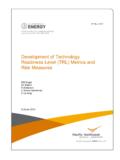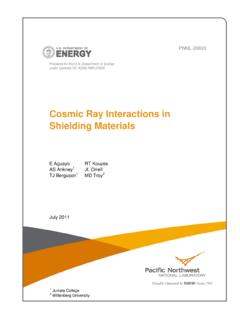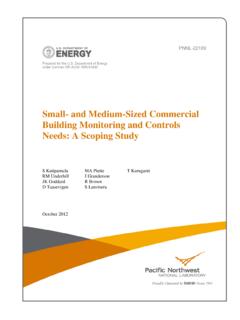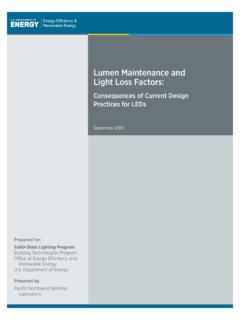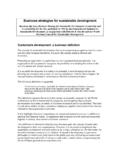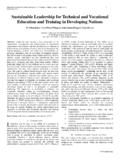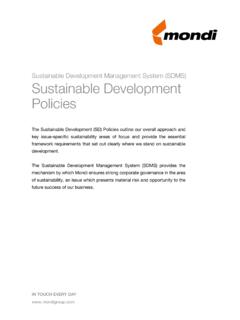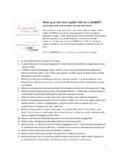Transcription of Best Practices for HPSB Guiding Principles …
1 PNNL-23347 Best Practices for HPSB Guiding Principles implementation in existing DOE Buildings May 2014 JH Henderson PNNL-23347 Best Practices for HPSB Guiding Principles implementation in existing DOE Buildings JW Henderson May 2014 Prepared for the Department of Energy under Contract DE-AC05-76RL01830 Pacific Northwest National Laboratory Richland, Washington 99352 iii Contents Introduction .. Inventory of Potential HPSBs .. Policies & Programs .. Prioritization Process .. Projecting and Tracking HPSB Conformance .. Conclusion .. Appendix A Definitions .. iv Figures Figure 1 - Example Indoor Water Use Calculation .. v Tables Table 1 - HPSB GPs for existing Buildings Summary.
2 Table 2 - Example Building Inventory .. Table 3 - Evaluation of Example Building Inventory .. Table 4 - Updated HPSB Inventory List .. Table 5 - HPSB GPs for existing Buildings - Table 6 - HPSB GPs for existing Buildings - Deploy .. Table 7 - HPSB GPs for existing Buildings - Performance .. Table 8 - HPSB Inventory Prioritization .. Table 9 - Example HPSB Conformance Schedule .. Introduction I. Background The intent of this paper is to document an approach to screening existing buildings at DOE sites for High-Performance and Sustainable Buildings (HPSB) Guiding Principles (GPs) potential, developing policies and programs to address a majority of the HPSB GPs, and how to prioritize buildings with the greatest potential. This paper will also include example strategies for HPSB inventory and projection schedules and best Practices on approaching and interpreting select criteria that have been troublesome to sites.
3 II. Authority A brief background of the Guiding Principles for Federal Leadership in High-Performance and Sustainable Buildings: January 24, 2006: The Federal Leadership in High-Performance and Sustainable Buildings Memorandum of Understanding (MOU) was signed at the White House Summit on Federal Sustainable Buildings. The MOU established a common set of sustainable Guiding Principles for integrated design, energy performance, water conservation, indoor environmental quality and materials. January 24, 2007: Executive Order (EO) 13423, "Strengthening Federal Environmental, Energy and Transportation Management" was signed to strengthen key goals for the Federal Government and require agencies to ensure new construction and major renovations comply with the 2006 Federal Leadership in High-Performance and Sustainable Buildings Memorandum of Understanding (MOU) December 5, 2008: High-Performance and Sustainable Buildings Guidance was issued by the Office of Management and Budget based on recommendations from the Interagency Sustainability Working Group (ISWG).
4 The 2008 guidance included a revised set of Guiding Principles for New Construction and a new set for existing Buildings. October 5, 2009: EO 13514, Federal Leadership in Environmental, Energy, and Economic Performance was signed that set sustainability goals for federal agencies and focuses on making improvements in their environmental, energy and economic performance. One of the EO 13514 targets is as follows: Ensuring that at least 15 percent of the agency's existing buildings (above 5,000 gross square feet) and building leases (above 5,000 gross square feet) meet the Guiding Principles by fiscal year 2015 and that the agency makes annual progress toward 100-percent conformance with the Guiding Principles for its building inventory; III. HPSB GPs for existing Buildings The HPSB GPs for existing Buildings are organized in five categories: I.
5 Employ Integrated Design Principles , II. Optimize Energy Performance, III. Protect and Conserve Water, IV. Enhance Indoor Environmental Quality, and V. Reduce Environmental Impact of Materials. Distributed among the five categories are 29 tasks. To better understand and manage the GPs, these 29 tasks can be grouped into three types of activities with unique implementation requirements: Policy: Campus or building policies and programs address management systems that enable a building to operate in a sustainable manner. Deploy: Tasks that may require deployment of building-specific technologies and building operating Practices ( Installation of Automated Lighting Controls/Sensors, Building Meters). Performance: The analysis of operating conditions and/or measured performance compared to baseline performance levels.
6 Table 1 below briefly summarizes the HPSB GPs for existing Buildings. Along with illustrating the corresponding category in the left column (I., II., III., IV., or V) and type of activity in the right column (Policy, Deploy, or Performance), a brief description of each task is also provided for context. For additional information refer to the December 5, 2008 Updated Guidance. Table 1 - HPSB GPs for existing Buildings Summary Inventory of Potential HPSBs I. Develop List of Buildings When approaching HPSB GPs for existing Buildings, the first step of an agency or site should be the development of an inventory of all buildings. Prioritizing buildings to meet the Guiding Principles can be particularly challenging at DOE sites where building inventories can be somewhat fluid.
7 Creating and maintaining an inventory of all buildings with a few key pieces of information can help to point to the best candidates and weed out those that are not viable candidates. The initial list should contain buildings constructed, renovated, leased, or purchased in whole or in part for use by the Federal Government1 and should include the following information: i. Building name or number ii. Building function iii. Square footage iv. Vintage and year of most recent major retrofit v. Owned or leased (length of lease) vi. EISA covered facility2 (Y/N) vii. Razed or conveyed by the end of 2015 (Y/N) viii. Measured energy and water performance (Y/N) ix. Baseline year energy and water performance (Y/N) Table 2 is an example inventory of buildings and the associated information that should be collected when screening buildings for HPSB appropriateness.
8 Table 2 - Example Building Inventory 1 Only include buildings that consume energy or water. 2 See Covered facility definition II. Identify Excluded and Low Priority Buildings The information from the developed inventory can be used to document which Federal buildings can be excluded from the HPSB GP goal and which may be lower priority or more difficult to achieve HPSB compliance. An agency may exclude from the HPSB inventory buildings that are not subject to the HPSB requirement: i. Any Federal building that does not expect to achieve the de minimis square footage (< 5,000 SF), or ii. Any Federal building that is expected to be razed or conveyed by end of 2015 Other criteria that may be indicators of low priority HPSB buildings: iii.
9 Short term leases iv. Unique building functions ( , large mission critical process loads or unique operations) Table 3 illustrates how the inventory data can be used to establish candidate buildings for the HPSB goal. As shown in the table, 8 buildings have been screened for inclusion in the inventory of potential HPSBs. Table 3 - Evaluation of Example Building Inventory Table 4 is an example updated HPSB inventory list after removing excluded Federal buildings. The data has been transposed in preparation for HPSB prioritization mapping. Table 4 - Updated HPSB Inventory List Policies & Programs Preceding the prioritization of buildings for HPSB conformance, establishing policies and programs is essential. By developing appropriate policies/programs, or highlighting existing documentation, agencies can address approximately 52 percent (15 of the 29 tasks) of the HPSB GPs for existing Buildings.
10 Table 5 summarizes the GP tasks generally associated with policies or programs. Table 5 - HPSB GPs for existing Buildings - Policy I. Mapping Global Policies & Programs to Guiding Principles Not only do global polices directly address the majority of the GP tasks, they can provide supporting documentation for various other GPs. The seven common policies and programs listed below will meet the requirements for 15 of the GP tasks for existing Buildings. Environmental Management System (EMS) EMS is a set of processes and Practices that enable an organization to reduce its environmental impacts and increase its operating efficiency. Sites/agencies are to incorporate sustainable operations and maintenance Practices within the appropriate EMS, establish goals, roles and responsibilities.





